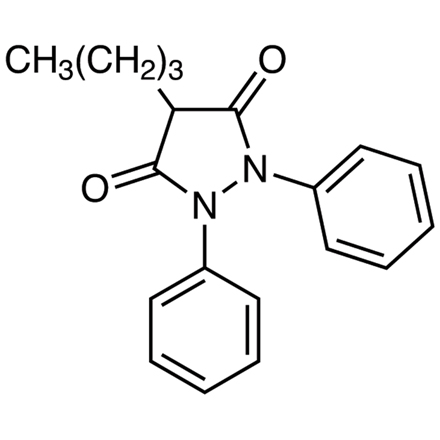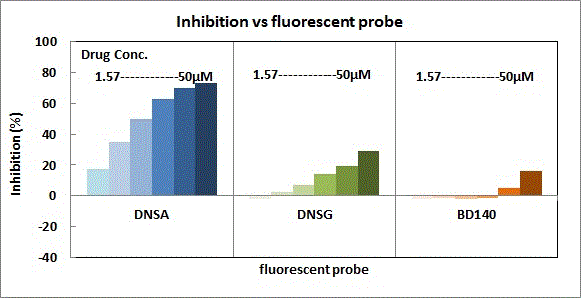Published TCIMAIL newest issue No.198
Maximum quantity allowed is 999
Merci de sélectionner la quantité
CAS RN: 50-33-9 | Numéro de produit: P1686
Phenylbutazone

Pureté: >98.0%(T)(HPLC)
Synonymes
- 4-Butyl-1,2-diphenylpyrazolidine-3,5-dione
Documents de produit:
| Taille | Prix unitaire | Belgique | Japon * | Quantité |
|---|---|---|---|---|
| 25G |
€26.00
|
4 | 9 |
|
| 500G |
€283.00
|
1 | 9 |
|
*Le délai de livraison pour des produits disponibles en stock en Belgique est 1 à 2 jours
*Le délai de livraison pour des produits disponibles en stock en Japon est 1 à 2 semaines (sauf des produits réglementés et des envois avec de la glace carbonique)
| Numéro de produit | P1686 |
Pureté / Méthode d'analyse 
|
>98.0%(T)(HPLC) |
| Formule moléculaire / poids moléculaire | C__1__9H__2__0N__2O__2 = 308.38 |
| Etat physique (20 ° C) | Solid |
Condition de stockage 
|
Room Temperature (Recommended in a cool and dark place, <15°C) |
| CAS RN | 50-33-9 |
| Numéro de registre de Reaxys | 290080 |
| Identifiant de la substance PubChem | 87558949 |
| Indice Merck (14) | 7277 |
| Numéro MDL | MFCD00005500 |
Spécifications
| Appearance | White to Yellow to Orange powder to crystal |
| Purity(HPLC) | min. 98.0 area% |
| Purity(Neutralization titration) | min. 98.0 %(after drying) |
| Melting point | 104.0 to 108.0 °C |
| Drying loss | max. 5.0 % |
| NMR | confirm to structure |
Propriétés
| Point de fusion | 106 °C |
| solubilité dans l'eau | Insoluble |
| Degré de solubilité dans l'eau | 0.2 g/l 25 °C |
| Solubilité (soluble dans) | Methanol |
SGH
| Pictogramme |

|
| Mot de signal | Danger |
| Mentions de danger | H301 : Toxique en cas d'ingestion. H315 : Provoque une irritation cutanée. H319 : Provoque une sévère irritation des yeux. |
| Conseils de prudence | P501 : Éliminer le contenu/récipient dans une installation d'élimination des déchets agréée. P270 : Ne pas manger, boire ou fumer en manipulant ce produit. P264 : Se laver la peau soigneusement après manipulation. P280 : Porter des gants de protection/ un équipement de protection des yeux/ du visage. P337 + P313 : Si l'irritation oculaire persiste: consulter un médecin. P301 + P310 + P330 : EN CAS D'INGESTION: Appeler immédiatement un CENTRE ANTIPOISON/un médecin. Rincer la bouche. |
Lois connexes:
| Numéros CE | 200-029-0 |
| RTECS # | UQ8225000 |
Informations de transport:
| Numéro UN | UN2811 |
| Classe | 6.1 |
| Groupe d'emballage (DOT-AIR) | III |
| N ° SH (import / export) (TCI-E) | 2933998090 |
Application
Binding of Phenylbutazone to Human Serum Albumin
Phenylbutazone is known to have affinity for Human Serum Albumin (HSA) and to bind (interact) to drug binding site I on HSA. Those were confirmed using our phenylbutazone with Surface Plasmon Resonance (SPR) and a method using fluorescent probes. 【SPR】 Dose responses of phenylbutazone to HSA were confirmed by SPR. Biacore, as a SPR biosensor, was used for the assay, according to the user’s guide of the instrument.

<Assay condition> Sensor Chip: Series S Sensor Chip CM5, Immobilization: HAS (Amine Coupling method), Buffer : 5%DMSO in PBS. <Result> “Square wave” sensorgrams were exhibited at each concentration, and concentration dependent binding of phenylbutazone to HSA was confirmed. 【Method using fluorescent probes】The drug biding site of phenylbutazone was confirmed using fluorescent probes which bind to drug binding site on HSA. Dansylamide (DNSA) [D5405] was used as fluorescent probe for site I, and dansylglycine (DNSG) [D5406], BD140 [D4898] were used as fluorescent probes for site II, and then bindings to site I and site II were confirmed.

<Assay condition> Buffer: 1 % DMSO in phosphate buffer (pH 7.2 - 7.5); HSA: 5 µM (DNSA), 20 µM (DNSG, BD140) (50 µL/well) (Fatty acid free HSA is recommended.); Phenylbutazone: each concentration (50 µL/well); DNSA: 80 µM, DNSG: 20 µM, BD140: 20 µM (50 µL/well); Incubation: 20-25 °C for 30 min; Measurement: plate-reader with excitation = 365 nm and emission = 480 nm (DNSA, DNSG), with excitation = 365 nm and emission = 585 nm (BD140). <Result> As shown in upper diagram, inhibition against binding of dansylamide which is fluorescent probe for site I by phenylbutazone was confirmed. And also, little or extremely weak inhibition against binding of dansylglycine and BD140 which are fluorescent probes for site II was confirmed. In these ways, our phenylbutazone can be used for study of interaction with HSA. Also, DNSA [D5405], DNSG [D5406] and BD140 [D4898] can be used for study of drug binding site on HSA.
References
- Fluorescent Dye Cocktail for Multiplex Drug¬Site Mapping on Human Serum Albumin
- High-resolution and high-throughput protocols for measuring drug/human serum albumin interactions using BIACORE
- Biosensor Analysis of the Interaction between Immobilized Human Serum Albumin and Drug Compounds for Prediction of Human Serum Albumin Binding Levels
- Characterizing a drug's primary binding site on albumin
- Structural basis of the drug-binding specificity of human serum albumin
PubMed Litterature
Articles de produit
Documents de produit (Note : Pour certains produits, les tableaux analytiques ne sont pas disponibles.)
Fiche de sécurité (FDS)
S'il vous plaît sélectionnez la langue.
La FDS demandée n'est pas disponible.
Nous contacter pour plus d'informations.
Spécifications
CoA et autres Certificats
Veuillez remplir le numéro de lot
Le numéro de lot saisi est incorrect. Veuillez saisir uniquement 4-5 caractères alphanumériques avant le trait d'union.
Exemple de CoA
Il s'agit d'un échantillon CoA qui peut ne pas représenter un lot récemment fabriqué du produit.
Un échantillon CoA pour ce produit n'est pas disponible pour le moment.
Graphiques analytiques

Veuillez remplir le numéro de lot
Le numéro de lot saisi est incorrect. Veuillez saisir uniquement 4-5 caractères alphanumériques avant le trait d'union.
Le tableau analytique demandé n'est pas disponible. Nous sommes désolés pour ce désagrément.





